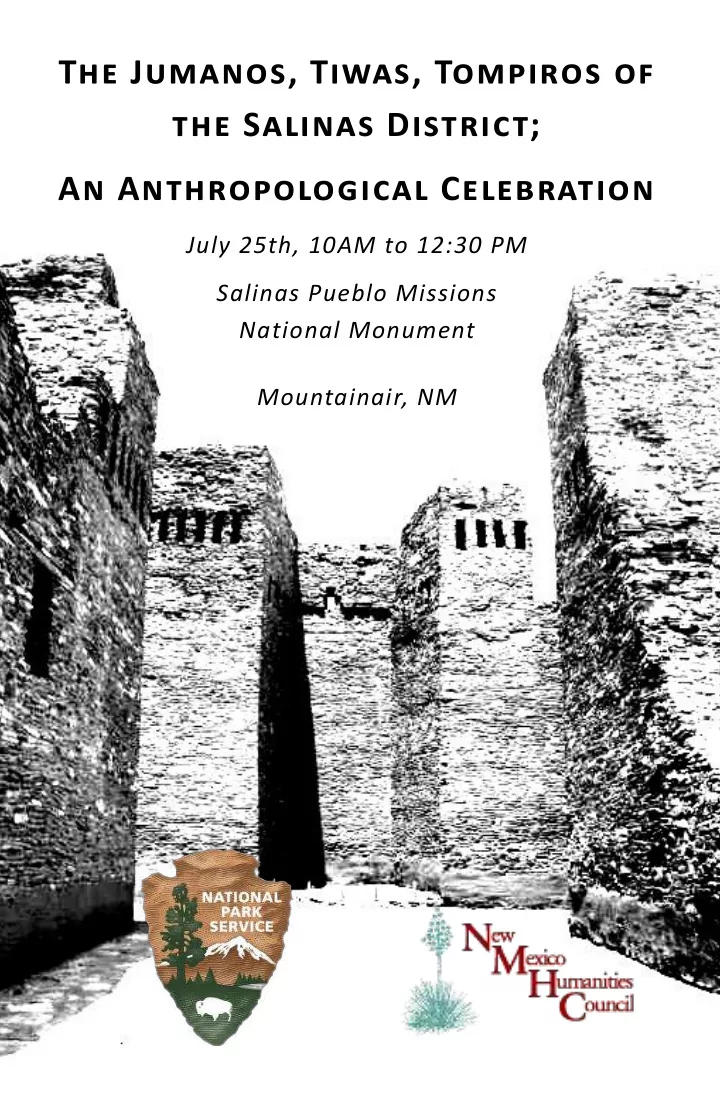

The Jumanos, Tiwas, Tompiros of the Salinas District; An Anthropological Celebration July 25th, 10AM to 12:30 PM Salinas Pueblo Missions National Monument Mountainair, NM
WHO WERE THE SALINAS PUEBLO JUMANOS AND ATZIGUIS? Deni J. Seymour, PhD, Research Associate, Jornada Research Instjtute An enduring mystery regarding the Salinas - area pueblos, including Gran Quivira/Las Humanas, is why these centers were called the Jumano Pueblos. Documentary sources relatjng to the Salinas pueblos indicate both that: (a) the Puebloans themselves were Jumano and (b) the mobile visitors were Jumano, as Fray Alonso de Benavides noted in the 1630s. This is consistent with the two types of adaptatjon recorded for the Jumano at La Junta de los Rios in Texas and, as it turns out, at the Eastern Frontjer Pueblos where Jumanos and Atziguis played a role. Archaeological evidence of mobile visitors gathered over more than a decade and reexaminatjon of early archival sources provide fresh perspectjves on this questjon. These new data highlight the infmuence and lastjng nature of Grand Narratjves in our understandings of history and the vital and actjve role of new informatjon. MARÍA DE AGREDA'S SIXTEENTH CENTURY APPARITIONS TO THE JUMANO AND THE TEJAS Joseph P. Sánchez, PhD, Director, Spanish Colonial Research Center, University of New Mexico María de Ágreda (1602 - 1665), a cloistered nun in Spain, is said to have appeared to Jumano and Tejas Indians in Texas and asked them to invite Franciscan missionaries from New Mexico to convert them to Christjanity. Among others, Fray Alonso de Benavides, who had served in New Mexico, investjgated the apparitjons of the “Lady in Blue” in the 1630s. Although subsequent investjgators showed that the evidence exaggerated her powers, María de Ágreda survived the tests of the Holy Offjce of the Inquisitjon. Stjll, stories of her ability and gifus of bilocatjon fmitued along the Spanish frontjer of East Texas for over 100 years. Whether the apparitjons be true or false, marvel or miracle, the stories of the Lady in Blue helped Fray Alonso de Benavides' promote New Mexico as a mission fjeld. Indeed, the Jumanos had played a signifjcant role in the growing support for contjnuing the work of the missions in the Custodio y Conversión de San Pablo de Nuevo México as well as missions in Texas.
A PRE - REVOLT MONOPOLY: THE EXTENDED ROMERO FAMILY, TRADE, AND THE JUMANO PUEBLOS Thomas E. Chavez, PhD, Historian, Retjred Executjve Director of the Natjonal Hispanic Culture Center in Albuquerque, Former Director of the Palace of the Governors in Santa Fe, New Mexico In the seventeenth century Spanish estancias sprang along the Camino Real almost as far south as Socorro. Many, if not most, of these establishments belonged to one extended family: all descendants of Bartolomé Romero. Under the guidance of Francisco Gómez the family ran a commercial business in which the Jumano Pueblos played a key role. In fact, those pueblos had something to do with the placement of, at least, two of the estancias. THE SALINAS PUEBLOS IN HISTORICAL PERSPECTIVE: INTERCULTURAL NETWORKS LINKING NEW MEXICO, NUEVA VIZCAYA, AND THE SOUTHERN GREAT PLAINS Gussenhoven Distjnguished Professor of History and Latjn American Studies, Cynthia Radding, PhD, University of North Carolina, Chapel Hill The vastness of the northern borderlands of the Viceroyalty of New Spain is captured in the phrase, gran septentrión, understood in terms of both geography and imperial dominion, as it is recovered from offjcial documents and colonial correspondence. Recent scholarly productjon in the fjelds of environmental history, archaeology, and ethnohistory have enriched the layered meanings of frontjer that are applied to difgerent scales of territoriality among imperial powers, indigenous confederatjons, and communitjes in discreet regions and localitjes. The trans - disciplinary insights afgorded by this research provide an excellent canvas on which to analyze the historical productjon of Amerindian spaces and landscapes in the frontjer societjes that were linked to regional corridors running through the gran septentrión. This presentatjon explores the materiality of space and the historical communitjes of the frontjer province of Salinas in eastern New Mexico with its connectjons to the Great Plains, to the east, and to the mining and mission provinces of Nueva Vizcaya, to the south. It places Salinas within the gran septentrión and interprets the cultural meanings of the frontjer for the Jumano and neighboring indigenous and Hispanic populatjons that shaped the region over tjme and sustained its connectjons to the Spanish imperial sphere of North America.
Today’s presentatjons will be evaluated by Rick Hendricks, PhD, who is the New Mexico state historian. He received his BA from the University of North Carolina at Chapel Hill in 1977 and his PhD from the University of New Mexico in 1985. He is a former editor of the Vargas Project at the University of New Mexico. Afuer the conclusion of the Vargas Project, he worked at New Mexico State University, most notably on the Durango Microfjlming Project. At NMSU Rick also taught courses in colonial Latjn America and Mexican history. He has writuen extensively on the history of the American Southwest and Mexico. Recent books include El Paso Prenuptjal Investjgatjons from the Catholic Archives of Texas, 1701 - 1853, coauthored with Robert D. Martînez (2014) and Four Square Leagues: Pueblo Indian Land in New Mexico, coauthored with Malcolm Ebright and Richard Hughes (2014). Rick is completjng a biography of Spanish - Mexican patriot, Father Antonio Severo Borrajo. TOURS WILL BE OFFERED AT ALL SITES FOLLOWING THE PRESENTATION: GRAN QUIVIRA: 1:30 — 2:30 PM QUARAI:3:15—4:15 PM ABÓ: 4:45 — 5:45 PM
Recommend
More recommend